Residence View of Blount Streeet, Raleigh, N.C.
Our Flashback Friday postcard this week captures the charm of a Raleigh now long lost. Seen here are some of the elegant residences that once lined North Blount St. Across the street in this view was the most elegant of them all — the Governor’s Mansion.
No message on our card this week. The view, though, depicts the 200 block of Blount St. as it appeared in the 1910s.
In the aerial photo below, that very block can be seen as it appeared about 1963, soon after the completion of North Carolina’s State Legislative Building. Within just a few years, all the residences seen here would be demolished.
Once What Was
Most folks today probably don’t realize that up until the 1960s, Blount Street north of New Bern Ave. was a residential enclave. Although most of the original families had long ago died off, and many of their former elegant homes chopped into apartments, the avenue even then still presented an air of 19th century  opulence.
The photo above shows how Blount St. appeared north of Peace St. in the early 1900s. The photo below of the 400 block was taken on a glass plate negative about the same time. Prominently seen are the streetcar tracks which once ran down the length of Blount from Edenton to Peace.
Several large homes, or mansions, if you will, once lined the 400 block. The one below was the residence of  Dr. William Hawkins and his family, built ca 1873. It was demolished in 1967.
The W.H. Pace home stood in the 400 block at the corner of Polk St. I took this photo with my trusty Kodak Instamatic camera in 1965.
I also took this photo of the turreted confection seen below in 1965. It stood across the street from the Pace home, on the opposite corner. Both homes had been demolished by 1967.
A Sad Goodbye
All the homes seen in this week’s postcard view were demolished in 1966 – 1967 to make room for the North Carolina State Archives and History and Library building. (That singular irony is hard for me to bear even now.)
One day in 1966, on one of my visits to Blount Street, with my trusty Kodak Instamatic in tow, I took this photo in the 200 block, just as one of the old grandes dames drew her last breath.
Our Flashback Friday ‘tinted-halftone’ postcard this week was published locally by the long-time Raleigh stationer, James E. Thiem. It was printed by Commercialchrome of Cleveland.
Commercialchrome  (1910-1920) Cleveland, OH
Printer of tinted halftone view-cards, most depicting scenes from the American Mid-West.
Tinted Halftone
A tinted halftone is a printed image by which the color is applied through hand drawn lithography in dots or solid fields, while the detail is rendered through a photographic halftone on a single key plate. A pallet of light red, yellow, and blue was the most commonly used. It began being used in the 1880’s as a way to incorporate color into photomechanical printing at a time when there was no good source of color photography. This method was replaced by process printing by the late 1930’s.
“Flashback Friday†is a weekly feature of Goodnight, Raleigh! in which we showcase vintage postcards depicting our historic capital city. We hope you enjoy this week end treat!

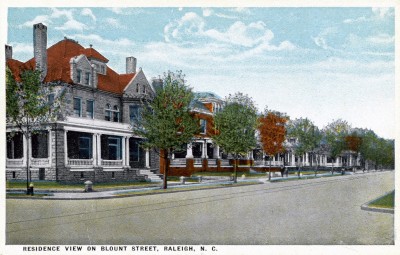
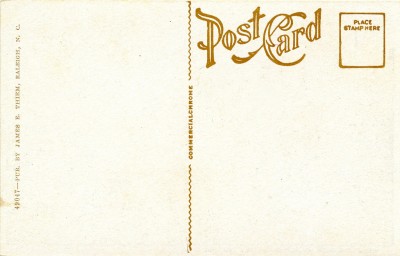
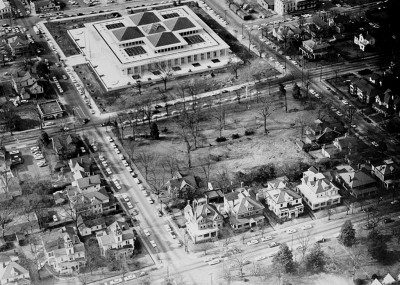

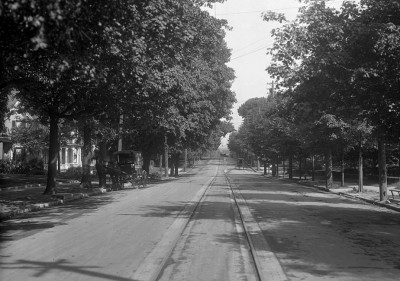
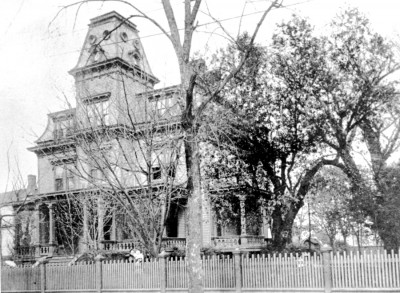
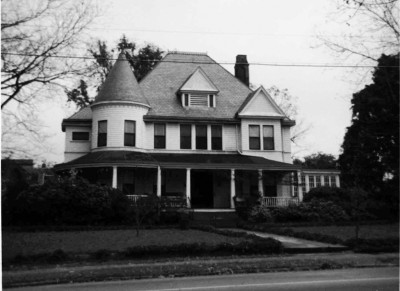
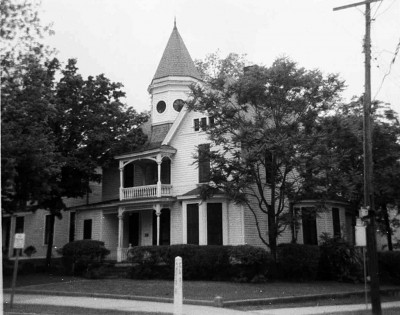
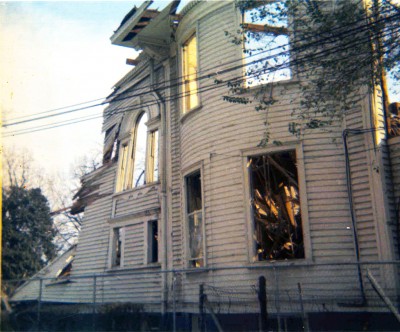
 Sign up for the Newsletter
Sign up for the Newsletter
09/13/2013
So glad you had your trusty Instamatic, RB.
09/13/2013
I could’ve sworn that William Hawkins home you listed as demolished was still there on Blount. There’s certainly one that looks just like it.
09/13/2013
My great-grandma lived at 121 North Blount Street. I have an old photograph of her and a lady that worked for her standing on the side porch. She turned her home into a boarding house when my great-grandfather died. Her name was Hannah Robinson Apple. I wish I could obtain some good pics of that particular home. Do you know any way to do this? Thanks!
09/13/2013
Fantastic post, Raleigh Boy. Where are some of the other Victorian-era houses made from gray stone as seen in the postcard? The only one I can think of is the house associated with Sacred Heart on the corner of Edenton and McDowell Streets.
09/13/2013
I work downtown and so happened to be walking down Blount Street today. As I walked, I was thinking of all the grand homes that filled the empty lots and parking spaces. I was thrilled when I opened my email to see this post! Do you have more photos of the street and area around government complex? I have always hoped someone would organize a book on the grand homes of Blount Street.
09/14/2013
John Morris: Don’t know that it’s Victorian-era, but the house with the big “P” (Poole house?) in the 2700 block, is a formerly grand house with that gray stone facade. On Google Street it’s looking pretty overgrown.
09/14/2013
That house is out Poole Rd.
09/15/2013
Judi,
Have you checked with Archives and History and Raleigh City Museum? They may have pictures you are looking for.
Adam,
Dr. William Hawkins house was gone before the 1940’s. I thought it burned and was then demolished anyway it is no more.
Dr. Alexander Hawkins (younger brother of William) home was the Hawkins-Hartness House and is the office for the Lt. Governor.
09/17/2013
There was a small house on Wilmington St. in the 100 block that was there until the 60’s. I believe the Busby house was on the corner of Wilmington and Jones and this house was either next to it or one house up. I was told that it was the home built for Rachel Blight Bauer. I wonder if anyone else remembers this house?
09/17/2013
Sorry it is supposed to be Rachel Blythe Bauer.
09/17/2013
“In thy dark eyes splendor
Where the warm light loves to dwell
Weary looks yet tender
Speak their last farewell”
“True worth is being, not seeming.”
09/17/2013
This is actually a verse from a song that was popular in the early 1900’s “Juanita”
The quote at the end I think was because the Women of Raleigh were not exactly cordial to Rachael.
09/18/2013
HWG: Me too — I only wish the film cartridge held more than 12 exposures, as had that been the case, I’d have many more pictures to share with GNR readers.
John Morris: Glad you enjoyed the article! Raleigh has plenty of ‘gray granite’ institutional buildings, but this ca 1900 Blount Street residence is only the only one I am aware of to have been built. There was an earlier ‘brown’ granite residence — the Wm W Vass house on Halifax St. It was built in the 1850s and demolished in the mid-20th century. There’s a photo of it in Mrs Waugh’s Raleigh book.
In the 1920s and ’30s there was a spurt of granite homes built in Raleigh. These included the Sacred Heart rectory, as you pointed out, (‘grey granite’ 1924); the Josephus Daniels mansion, ‘Wakestone,’ (‘brown’ granite 1920) in Hayes Barton; the Poe mansion (1920s), ‘Longview,’ near Wake Med (which now owns it); the Willis Smith house (1920s), off Glenwood at the St Mary’s St intersection; and the house on Poole Rd (1930s), among others. Many other examples constructed of this ‘brown’ granite (Falls leuocogneiss) can be seen on a drive through the Cameron Park, Hayes Barton, Budleigh and Five Points neighborhoods.
Judi: I have seen a photo of the house at 121 Blount in state archives. It was built about 1875 by wealthy hardware merchant Wm A Myatt. His house is the second one from the SW corner of Jones and Blount as seen in the aerial view. Was your family related to the Myatts?
Interested: Dr Wm J Hawkins built a house across North St for his brother Dr Alex B Hawkins as a ‘surprise’ for his brother and his wife in 1882. It still stands and is currently occupied by the Lieutenant Gov’s office. http://www.ltgov.state.nc.us/hhh.aspx
Adam: The Dr WJ Hawkins house stood at the NE corner of Blount and North until 1967 when it was demolished by the state. By then it had lost its distinctive tower. You may be thinking of the Heck-Andrews house which still stands at 309 N. Blount.
Diana: I have several photos of many of the old Blount Street mansions. I will place them in an album, and publish it on the Goodnight Raleigh facebook page this weekend — so keep an eye out!
09/18/2013
One of the the Myatt’s lived on the corner of Lane and Wilmington. Which one was that. It was a grey brick I believe. I remember they had a sailboat in the back yard that I believe belonged to their son. I used to go play with Mrs. Myatt’s granddaughter Betsy.
09/18/2013
Was James Thiem the tinter of the postcard the father of Jimmy Thiem who had the record store over the Ambassador Theater and then moved to the corner of Hargett and Salisbury?
09/18/2013
Hi! And thanks for the info. No..we are not related to the Myatts. I only know she lived there and ran it as a boarding house in the 1920’s and 1930’s. I will be making a trip to Archives and History to see if I can get a copy of a good picture. The one I have only shows the side porch…and the beautiful gingerbread-ish trim! Thanks soo much – Judi
10/07/2013
The first birds eye photo in this series clearly shows that the antebellum mansion that was on this lot had just been cleared. I think it was called the Dortch House. Some history remains though as several of its yard trees survive on the NW corner of this square. The house and its yard once occupied the whole block if I remember correctly, and this is borne out by the cleared spot being in the center of the block.
10/17/2013
Also as a side note one of the Hawkins carriage houses still stands at 406 east Lane Street, moved and repurposed as a residence.
11/14/2013
Interested asked: “Was James Thiem the tinter of the postcard the father of Jimmy Thiem who had the record store over the Ambassador Theater and then moved to the corner of Hargett and Salisbury?”
Yes indeed…James Sr. was the stationer and Jimmy/James Jr. was his son. James Sr. was married to my grandmother’s aunt; Jimmy was G-mother’s cousin although she was a good bit older. Jimmy was closer in age to my dad (now almost 90) than to my G-mother. James Sr. and wife Eula lived at 1508 Hillsborough St. (demolished in 1970’s) which stood across the street from the Velvet Cloak Inn and in its last years was home to NC State’s Theta Chi fraternity. We have photos showing my G-mother on Thiems’ front porch in 1923 holding her baby son (my dad) with Jimmy who appeared to be about 7 or 8. In later years, both G-mother and her cousin Jimmy were very active in Raleigh Little Theatre.